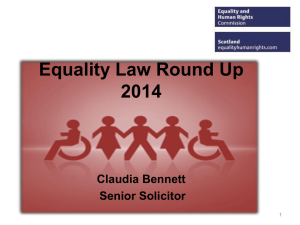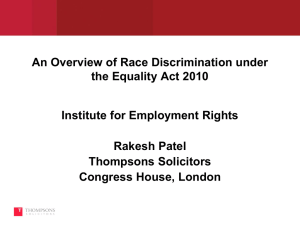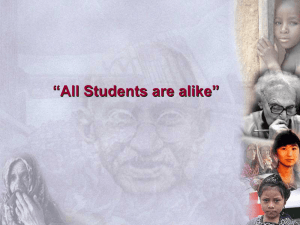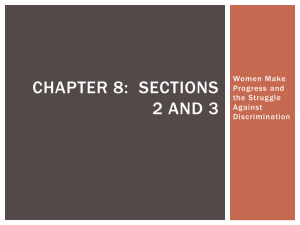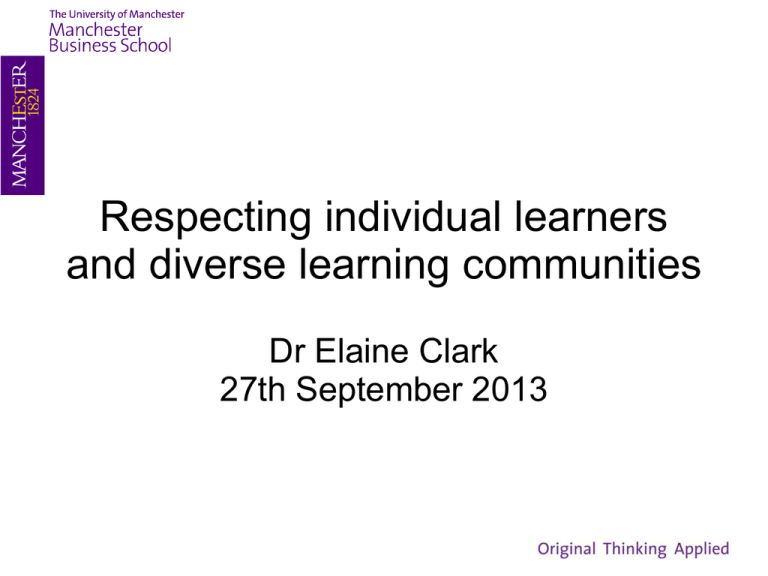
Respecting individual learners
and diverse learning communities
Dr Elaine Clark
27th September 2013
Objectives…
• By the end of this session you will have
•
awareness of the key drivers relating to this topic and
awareness of its growing import.
•
awareness of some of the ways in which you can work to
respect individual learners and diverse learning communities.
•
planned a session which identifies strategies that will engage
diverse learners.
Key drivers
Areas of
Activity
Core
Knowledge
Professional
values
UK Professional Standards Framework
(2012)
Dimensions
Professional values
• Respect individual learners and diverse
learning communities
• Promote participation in higher education
and equality of opportunity for learners
• Use evidence informed approaches
• Acknowledge wider context in which
higher education operates
Of the 491,300 participating in further
education in 2011
• 54.0% were female, 46.0% were male
• 15.5% of learners declared a learning difficulty,
disability or health problem
• 21.0% were from a Black or minority ethnic
background
• 39.7% were aged under 19; 14.1% were aged
19-24 and 46.1% were aged 25 or older.
Department for Business, Innovation &
Skills ( 2011)
Key aim for HE sector is to embed equality
Recruiting, and ensuring success for, a more diverse student population remain
key priorities for the UK funding councils HEFCE’s Strategic Priorities in
Widening Participation (2006–2011) in order that it becomes “part of the
norm for the sector”(HEFCE 2006)
Institutions are required to respond to key performance indicators (KPIs) with
respect to widening access and participation.
For instance, in England, HEFCE have set KPIs to increase participation in
higher education and to increase the proportion of students (full-time and
part-time, both young and mature) from under-represented groups in HE,
together with a continued commitment to embed support for disabled
students.
Equality legislation
Equality Act 2010
“…everyone has the right to be treated fairly at
work or when using services.”
• An attempt to simplify and strengthen the law relating to
equalities.
• Recognises nine factors - called 'protected
characteristics' - that are known to contribute to
disadvantage and discrimination in people's lives
• Section 36 imposes a duty to make reasonable
adjustments to prevent discrimination against an
individual with disabilities
• Outlaws any form of discrimination
Defining discrimination
Under the act, there are six different types of discrimination
Direct discrimination occurs when someone is treated less favourably than another
because of a protected characteristic.
Associative discrimination is discrimination against someone because they are
associated with another person with a protected characteristic.
Discrimination by perception is direct discrimination against someone because others
think that they possess a particular protected characteristic. They do not have to
actually possess the characteristic.
Indirect discrimination occurs when a rule or policy applies to everyone but
disadvantages a person with a particular protected characteristic.
Harassment is behaviour that offends the recipient. People can complain of behaviour
they find offensive even if it is not directed at them.
Victimisation is when someone is treated badly because they have made or supported a
complaint or grievance under this legislation.
Discrimination
A student dresses flamboyantly and is
somewhat effeminate. He is abused by
other students who think he is gay. In fact,
he is straight. What kind of discrimination
is this?
A course director has a policy of reminding
potential students of important
appointments and coursework deadlines
solely by telephone. The course has a
wide selection of students, including deaf
and visually-impaired students. What form
of discrimination is this?
STUDENT DIVERSITY – STUDENTS AS
INDIVIDUALS
In groups of 3 or 4, come up with a list of
ways in which our students might
demonstrate diversity?
Equality Act 2010: Protected
Characteristics
• Age.
• Disability.
• Gender reassignment.
• Married or in a civil partnership (not generally counted
as protected in service contexts).
• Pregnancy and maternity .
• Race.
• Religion or belief.
• Sex.
• Sexual orientation.
Disability and learning difficulty
• Disability: ‘ a physical or mental impairment
which has a substantial and long term adverse
effect on a person’s ability to carry out normal
day to day activities’ Disability discrimination act
1995
• Learning difficulty: those who have ‘a
significantly greater difficulty in learning than the
majority of people of that age, or a disability
which prevents the use of facilities generally
provided by post-16 training’ Learning and Skills
Act 2000
Differently abled
STUDENT DIVERSITY – STUDENTS AS
INDIVIDUALS
Approaches
to learning
Respecting individual learners
and diverse communities
As a group consider the ways in which you
could respect, and proactively work to
enhance the learning experience of, the
learners within the category defined.
Principles and strategies
Create ‘safe’, inclusive spaces
• Get to know students as individuals
• Establish ground rules for collaborative learning
• Ensure that every one has the chance to participate
• work with the student (s) to identify how the learning
space can be adapted to enhance participation
Harness students’ experience
and knowledge
• Start with what students know, then apply
theory
• Connect with students’ lives and future
aspirations
• Facilitate uncertainty, confusion &
difference
• Encourage articulation of thinking &
problem solving
Teach reflexively and with
sensitivity to differences
• Mindful of impact of own beliefs and
identity on student learning
• Coordinate interaction, mixing different
students (with a purpose)
• Anticipate, prepare & respond flexibly to
different and emerging requirements and
interests
Planning
• Consider resources that can enhance access
• Consider learning activities
• Consider student groupings
• Consider assessment
Planning for diversity
In groups of five or six, think of a session
that you have run or will be running soon.
Identify a suitable one between you.
Prepare a plan for that session with a focus
upon how you will respect student
diversity. I would like you to focus on just
one of the categories of diversity.
Consider resources, activities, how you will
evaluate the session.
This morning you have shown
awareness of…
• Areas of activity
• Designing and planning activities
• Supporting learning
• Developing effective learning environments and approaches to
support and guidance
• Core Knowledge
• Appropriate methods for teaching, learning and assessing
• Professional values
• Respecting individual learners
• Promoting participation
• Acknowledging wider context
Sources of support
• Course director
• Student support and assessment centre
• University of Manchester website
• Myself: elaine.clark@mbs.ac.uk
Any questions
References and resources
Anglia University resource pack for diversity
http://www.staffnet.manchester.ac.uk/services/equalityand-diversity
Department for Business, Innovation & Skills (2011) Post16 Education & Skills Statistical First Release DS/SFR
http://www.thedataservice.org.uk/NR/rdonlyres/A04B9E58DD37-42BA-91DB8593C893D13F/0/SFRcommentaryFINALPublished.pdf
Accessed 25/09/13
University of Manchester Website
• http://web.anglia.ac.uk/inclusive_practice
MBS – Student support and assessment
centre
Disability toolkits www.disabilitytoolkits.ac.uk.




